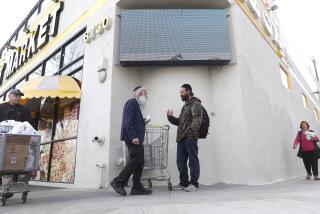Bridging Cultures : Seminar to Examine Differences, Similarities of Japanese, Jews
- Share via
When Japanese American anthropologist Kaoru Oguri was married to a Jewish man, she was struck by how much her in-laws talked at the dinner table.
“I used to tell my mother, ‘The Jews are the only ones who can hold three different conversations at the same time and still manage to eat dinner,’ ” said Oguri, curator at the Japanese American National Museum in Little Tokyo, in whose culture dinner is eaten in silence.
And when Jewish historian Eric Saul, curator of the Holocaust Oral History Project, interviews people of Japanese ancestry, he is sometimes perplexed by their silence. “You have to ask the same question three times before you get an answer,” he said.
The Japanese emphasis on modesty versus the Jewish valuing of articulation is just one of the differences that will be explored Sunday--along with some lesser-known similarities--in what is being billed as the first international conference on the subject.
Participants in the all-day seminar at the Stephen S. Wise Temple in Bel-Air include Ben-Ami Shillony, an internationally acclaimed authority on the Jews and Japanese at Hebrew University in Jerusalem. The conference is sponsored by the oral history project, based in San Francisco.
The Jews and Japanese have been intertwined in each other’s collective destiny ever since Shakespeare’s “Merchant of Venice” was introduced in Tokyo in the 19th Century.
Their relationship jelled when an American Jewish banker, Jacob Schiff, helped Japan raise the loans it needed to defeat the Russians in the Russo-Japanese War of 1904-05.
And during the peak of Nazi Germany, Japan sheltered more than 30,000 Jewish refugees, even though the Japanese government sided with Hitler.
*
That the first dialogue of Jews and Japanese is taking place in Los Angeles is appropriate. This region has the highest combined number of people of Jewish and Japanese ancestries in the world.
The Jewish population globally is 13 million, of which 6 million are in the United States. In contrast, Japan has 130 million people and Japanese Americans number about 1 million.
The two groups also have different religious backgrounds.
“The Jews came from a monotheistic creed, in which an almighty God expected them to obey his commandments and observe his rules,” Shillony said.
“The Japanese arrived from a polytheistic, nature-oriented way of life, which emphasized spirituality but tolerated different faiths and made few demands.”
Another difference is that Jews have a long tradition of living in alien lands but the Japanese do not.
Yet there are also striking similarities in their core values.
“Both communities place an enormous value on education as a means of social mobility,” said Don T. Nakanishi, director of UCLA’s Asian American Studies Center.
In the United States, both groups have experienced oppression and racism, said Mitchell Maki, assistant professor of social welfare at UCLA and a conference speaker. Yet they were able to overcome their adversities and have done well, he said.
There are numerous but little-known incidents that should help bring the two communities together.
Shillony says Japanese women should thank a “redheaded Jewish girl” for the provisions guaranteeing equality of the sexes in the Japanese Constitution.
Beata Sirota, 22, who spoke Japanese, had gone to Japan after World War II to look for her father, violinist Leo Sirota, who had escaped Nazi Germany.
While there, she worked for Gen. Douglas MacArthur, supreme commander of the Allied forces. When MacArthur’s people wrote a new constitution for Japan modeled after the U.S. Constitution, Beata, an ardent feminist, got the equal rights clauses in.
The audience will also hear from Hiroki Sugihara, the eldest son of the late Japanese diplomat Chiune Sugihara, who helped save the lives of 6,000 people fleeing advancing Nazi soldiers.
Sugihara was 5 when he saw Jews lined up outside the Japanese Consulate in Lithuania for visas.
“Daddy, please help them,” Hiroki told his father, even though he was too young to know why Jews were fleeing.
And those attending the conference will learn that Japanese American soldiers--whose families were interned--liberated Jews from the infamous Dachau concentration camp during World War II.
“We want to see each other’s communities through the other’s lens,” said Deborah Kattler Kupetz, conference chairwoman. “These historical incidents provide that opportunity.”
More to Read
Sign up for Essential California
The most important California stories and recommendations in your inbox every morning.
You may occasionally receive promotional content from the Los Angeles Times.










